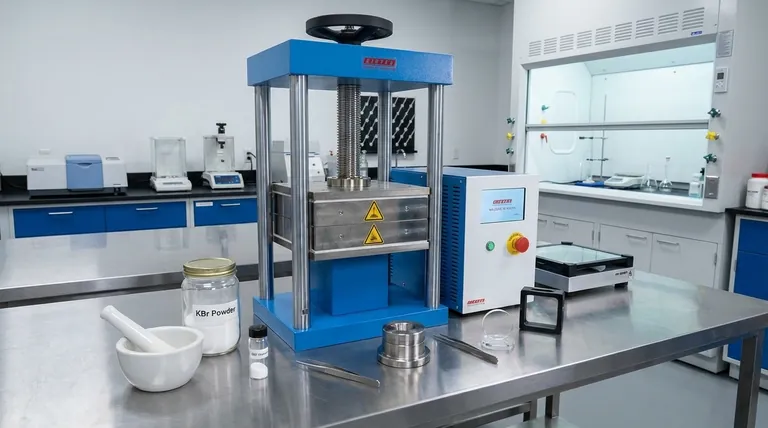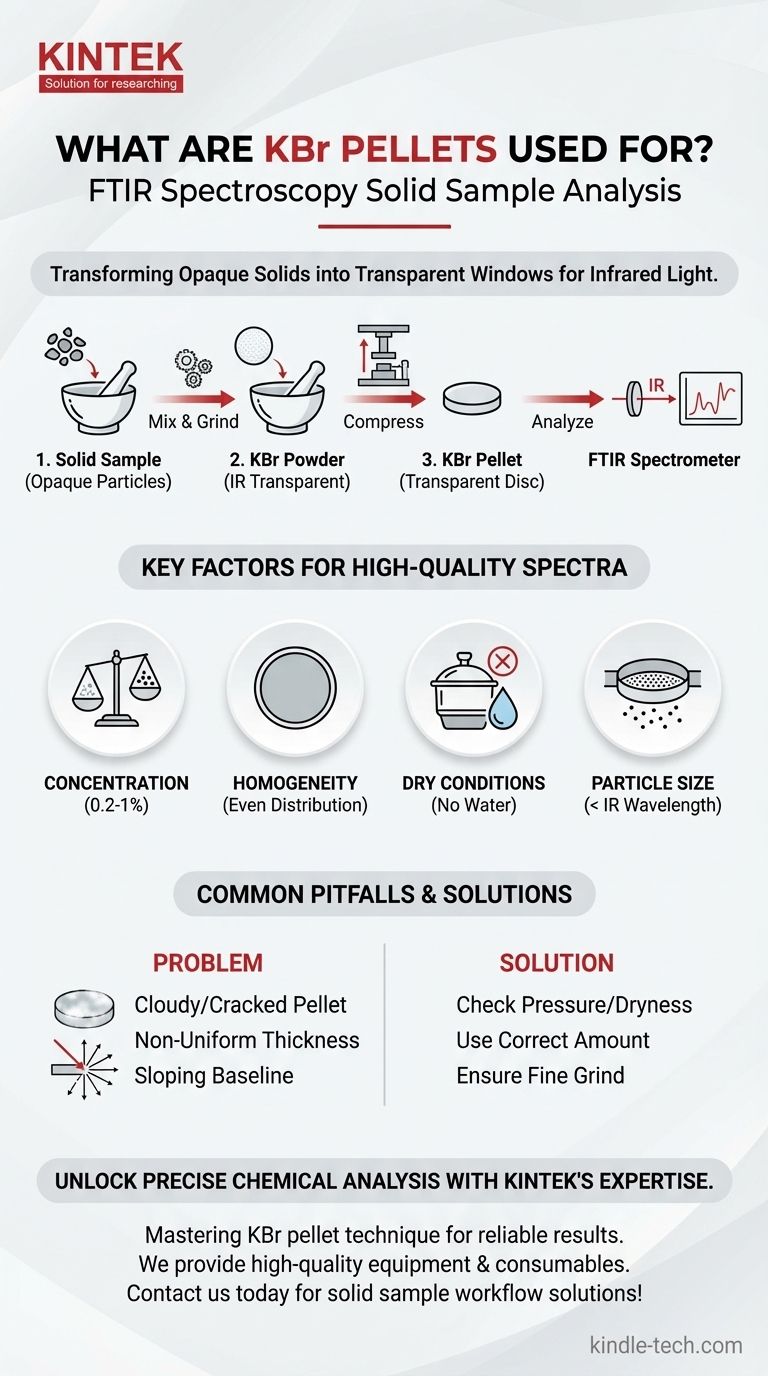在分析化学中,KBr 压片是使用傅里叶变换红外(FTIR)光谱法制备固体样品进行分析的标准且基本的方法。该技术涉及将少量固体样品与纯溴化钾(KBr)混合,并将混合物压缩成薄而透明的圆片。此过程允许光谱仪的红外光穿过样品,否则样品将是不透明的。
固体样品的基本挑战是它们对红外光不透明。KBr 压片通过将固体样品分散在对红外辐射透明的溴化钾 (KBr) 基质中来解决这个问题,有效地将样品变成分析的“窗口”。
为什么 KBr 是固体样品分析的标准
了解为什么这种特定方法如此普遍,需要考察固态分析的挑战和溴化钾的独特特性。
固体样品的挑战
大多数固体材料是不透明的,它们要么完全阻挡红外光束,要么散射红外光束。这使得无法获得有用的吸收光谱,而吸收光谱依赖于光线穿过物质来测量吸收了哪些频率。
KBr 的独特特性
溴化钾是该技术的理想介质,原因有二。首先,它在绝大多数中红外范围内对红外辐射是透明的,这意味着它本身没有吸收峰会干扰样品的谱图。其次,它是一种柔软的晶体盐,在压力下会流动,使其在压缩时能够形成固体、类似玻璃的透明圆片。
压片如何实现测量
当细磨的样品均匀分散在 KBr 基质中时,单个样品颗粒会悬浮起来。红外光束穿过透明的 KBr,其能量仅被样品颗粒内的化学键吸收。然后检测器记录下哪些频率被吸收,从而生成样品独特的谱图指纹。

高质量谱图的关键因素
您的 KBr 压片的质量直接决定了您结果的质量。制作不佳的压片会产生有噪声且无法解释的光谱。
浓度的关键作用
样品在 KBr 中的浓度至关重要。理想范围通常是按重量计 0.2% 至 1%。
由于固体压片比典型的液体样品膜厚得多,因此需要非常低的浓度。样品太少会导致峰值微弱,几乎难以检测。样品太多会导致红外光束被完全吸收或散射,从而产生“平坦”的峰值和非常嘈杂的光谱。
均匀性的重要性
样品必须研磨成细粉末,并与 KBr 粉末均匀地混合。这确保了样品在整个压片中均匀分布。
混合不均匀会导致红外光穿过压片的不同部分时吸收和散射不一致,从而扭曲光谱,使其不能代表块状材料。
水污染问题
溴化钾是吸湿性的,这意味着它很容易吸收空气中的水分。水在红外光谱中具有非常强且宽的吸收峰。
如果您的 KBr 粉末、样品或压片模具没有完全干燥,光谱中就会出现水峰,可能会掩盖您实际样品的重要峰值。这就是加热模具和使用干燥 KBr 至关重要的原因。
理解权衡和常见陷阱
获得清晰、透明的压片是一项技能,需要避免几个常见的错误。
陷阱 1:不正确的粒径
您必须研磨样品,而不是 KBr 粉末。样品颗粒必须小于红外光的波长,以防止光散射(称为米氏散射)。大颗粒会导致基线倾斜并降低光谱的清晰度。
陷阱 2:浑浊或开裂的压片
浑浊或不透明的压片是问题的明确信号。这通常是由于压力不足、截留空气或水分造成的。如果样品浓度过高,也可能发生这种情况,因为这会阻碍 KBr 正确聚结成透明圆片。
陷阱 3:厚度不均匀
使用过多的 KBr/样品混合物可能会产生过厚的压片。过厚的压片可能难以压制成透明状态,并可能导致吸收峰过强。一个好的压片仅使用足够的材料来形成一个薄而均匀的圆片。
为您的分析做出正确的选择
KBr 压片技术用途广泛,但您的具体目标决定了您需要关注的重点。
- 如果您的主要重点是定性鉴定:您的主要目标是消除污染。确保您的 KBr 是干燥的,并且您的研磨设备是干净的,以防止水分或其他残留物产生虚假峰值。
- 如果您的主要重点是定量分析:您必须优先考虑精确的样品浓度和完全均匀的混合物,以确保光谱强度与样品量直接且一致地成比例。
- 如果您正在对有噪声或倾斜的光谱进行故障排除:首先,检查样品的粒径和压片的物理清晰度,因为光散射是这些问题最常见的原因。
掌握 KBr 压片技术可以将原本繁琐的程序转变为释放固体材料化学身份的强大工具。
总结表:
| 关键因素 | 对高质量光谱的重要性 |
|---|---|
| 样品浓度 | 关键范围:按重量计 0.2% 至 1%。过多会导致噪声;过少会导致峰值微弱。 |
| 均匀性 | 确保样品在 KBr 中均匀分布,以获得一致、准确的光谱结果。 |
| 干燥条件 | 防止水污染,水污染会用强吸收峰掩盖样品峰。 |
| 粒径 | 样品颗粒必须小于红外波长,以避免光散射和基线问题。 |
利用 KINTEK 的专业知识,在您的实验室中实现精确的化学分析。
掌握 KBr 压片技术对于获得可靠的 FTIR 光谱结果至关重要。在 KINTEK,我们专注于提供高质量的实验室设备和耗材——包括可靠的 KBr 和压片机——以帮助您每次都能获得清晰、无污染的光谱。
无论您是专注于定性鉴定还是定量分析,我们的产品都能满足实验室专业人员的严格要求。让我们用确保准确性和效率的设备来支持您的研究。
立即联系我们,了解 KINTEK 如何增强您的固体样品分析工作流程!
图解指南




















